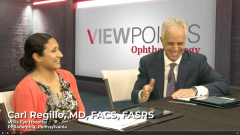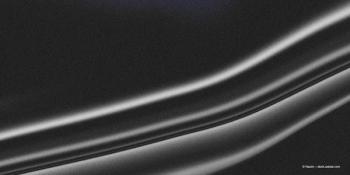
Treatment Goals in Neovascular AMD
Retina experts discuss treatment of wet AMD, focusing on frequency of treatment and treatment breaks, and fluid tolerance.
Episodes in this series

Nathan Steinle, MD: Dr Rao, of course, we want to give patients vision. We’re fighting for a vision. What else are you fighting for, for these patients? What else do you follow?
Prethy Rao, MD, MPH: So not only vision. Obviously, we look at the intraretinal fluid, subretinal OCT [optical coherence tomography] characteristics but also subretinal hemorrhage, recurrence of hemorrhage, and then looking at the characteristics on the OCT of CMV [cytomegalovirus] enlargement.
Oftentimes patients can be dry so to speak but their CMV lesion slowly, steadily gets bigger. They end up having that big event with the hemorrhage, so that’s the big thing. What Dr Regillo mentioned with following the other eye because we can often catch the fellow eyes earlier and you’re able to save vision a lot faster.
Nathan Steinle, MD: Interesting. And now, an open question to all 3 of you is, in my clinic, I don’t typically go to a lot of PRN [pro re nata] therapy. I still kind of do CT PRN. Do you guys ever stop treatments in these wet patients?
Prethy Rao, MD, MPH: I would say for me in my practice, no. I usually get them out to about the 3-month mark. Historically, I have been offering patients the PRN treatment if they want to but several studies have come out and said that the rate of recurrence over the next year is pretty high. I’ve seen reports of 1 in 4 patients, so I have that discussion. I’ve learned more about maintenance injections every 3 months.
Nathan Steinle, MD: What do you do Dr Scott?
Adrienne Scott, MD: I feel similarly to Dr Rao’s comments that it’s important especially for the patient to understand this is a lifelong disease of monitoring and so sometimes they can be lulled into a false sense of security with a dry OCT, good vision and think that their disease is “cured.” It’s not because, as Dr Rao mentioned, sometimes they can present suddenly with a subretinal hemorrhage a year after their last injection. It’s important to follow them regularly so that patient understands that they have to be monitored for their lifetime. I also will see them back about every 3 months. I don’t necessarily do a lot of PRN treatment as well.
Nathan Steinle, MD: I think we’re all pretty similar. Dr Regillo, anything different?
Carl Regillo, MD, FACS, FASRS: No. We have complete consensus. You’re absolutely right that the literature supports that reactivation will occur at some point, and it often is typically within a year just as you stated. It doesn’t make sense to stop therapy. It puts an eye at risk for having a recurrence and that recurrence could be big and sometimes a setback such that we can’t recover fully from it. It should be continuous therapy. It’s been tested; treat, extend, stop, treat, extend, followed by PRN. That could work but if you’re going to do PRN, you’re obligated to follow those patients very frequently. It turns the burden back on the patient to have to come to the office on a frequent and regular basis. Now, that could change with time in the future of other ways to image telemedicine approaches and such but for now having to come to the office and get an office-based OCT is the best way to pick up on disease activity.
Nathan Steinle, MD: To piggyback off that, so when you have disease activity a lot of times you have fluid either intraretinal fluid or subretinal fluid, and Dr Regillo, I’ll throw it back to you. Do you base your treatment decisions on where the fluid is and the type of fluid?
Carl Regillo, MD, FACS, FASRS: That is a very good question because our thoughts about fluid and fluid tolerance is evolving. I still, however, think it’s best and safest to adhere to strive for a drier or driest macula as possible and to keep it dry, and I’ll tell that to patients. We’ll start treatment to dry the macula the best we can, as completely as possible and our goal is to keep it that way. That’s the best way we know to keep the visual acuity gains that we typically get and maintain them the best over the long haul. The long haul is life—3, 5-plus years usually.
However, that being said, certain compartments and degrees of fluid might be tolerated, small amounts of subretinal fluid in particular especially if there’s not a lot of fluctuation. I think we can all agree there are situations where that can be tolerated and there are studies to back that up. True intraretinal fluid is a bad prognostic sign and studies are very consistent in showing that that leads to vision decline over time. So, for neovascular AMD [age-related macular degeneration] we should definitely do our best to maintain a dry neurosensory retina and potentially tolerate small amounts of, we’ll say, minimally fluctuating or nonfluctuating subretinal fluid.
Nathan Steinle, MD: Dr Rao, anything else to add on top of that?
Prethy Rao, MD, MPH: No. I agree 100% with Dr Regillo, who is extremely smart. I think there’s also a distinction between true intraretinal fluid from the actual CMV lesion and intraretinal fluid from RPE [retinal pigment epithelium] dysfunction. I think we’re quick to treat and say we’re seeing fluid but it’s not a fluid. I want to look at the characteristics of the RPE function and to be able to make that decision and see if it’s the disease state rather than just more of a dysfunction as a consequence of their disease.
Nathan Steinle, MD: That’s a really good point. Sometimes I’ll bring a patient back in 2 weeks after an injection just to see if it’s a response at all to anti-VEGF or if it’s a degenerative microcyst. That’s a good point.
Transcript edited for clarity
Newsletter
Keep your retina practice on the forefront—subscribe for expert analysis and emerging trends in retinal disease management.

















































